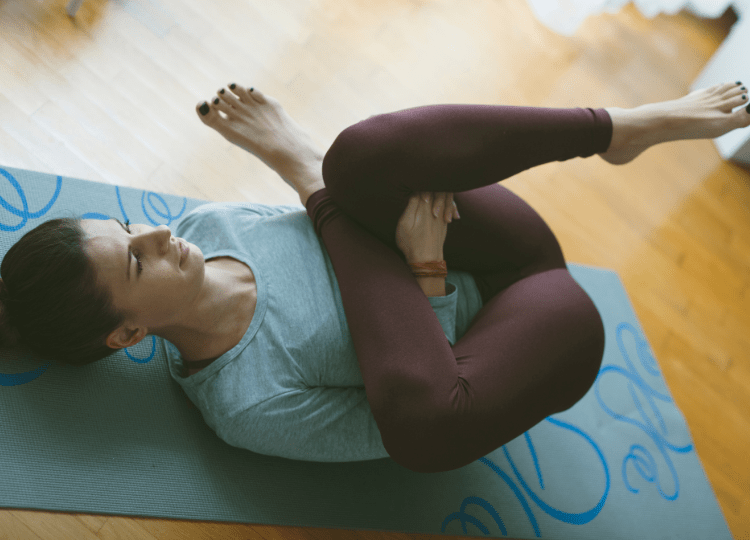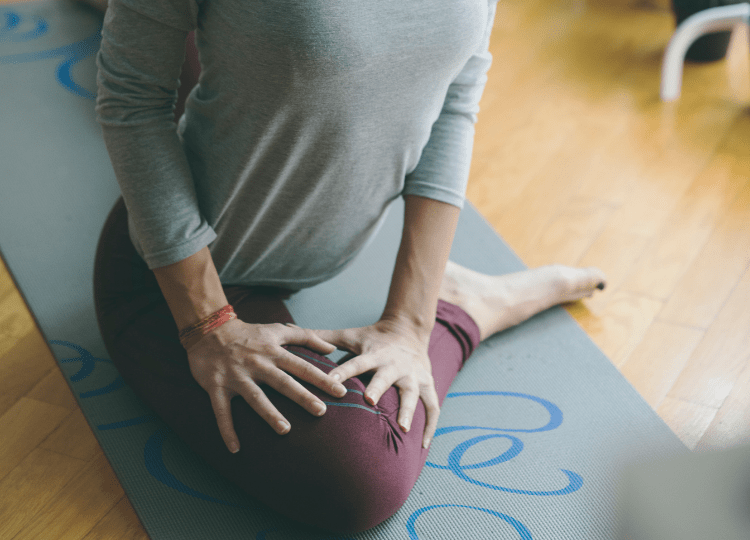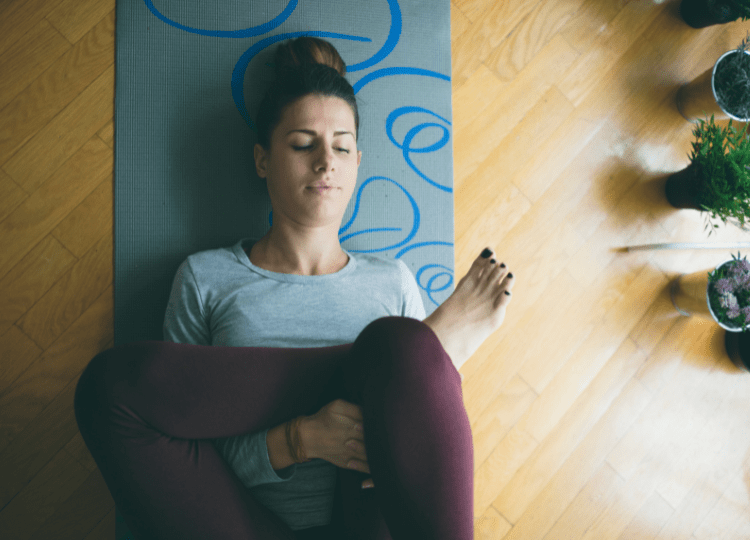Reclining pigeon pose is a gentle lower back and hip stretch. It is beginner friendly, requires no equipment and can be used as an effective way to alleviate symptoms of sciatica as well as other problems associated with tight hips and a lower back.
Whether you’re a passionate yogi, or just looking for effective ways to stay strong and supple, the reclining pigeon pose can be used in all sorts of daily stretching routines.
In this guide, we outline everything you need to know about the reclining pigeon pose, including how to perform it safely, muscles worked, benefits and things to consider.
So, without further ado, grab your yoga mat, don your athleisure wear and get your ommmm on…

What is the Reclining Pigeon Pose
The reclining pigeon pose (also referred to as Supta Kapotasanais) is a variation to the pigon pose. It can also sometimes be called “dead pigeon”, “reverse pigeon pose” or “eye of the needle”.
It is performed on your back and this inherently makes it easier than the regular pigeon pose (which is more of a lunge position). Performing the stretch on your back is ideal for beginners and those looking for a gentle stretch.
It can be used as a way to progress to pigeon pose, or as a standalone stretch that provides a plethora of benefits in itself.
The move is focused on opening up the hips and lifting the lower back slightly, which helps to provide a beautifully welcome stretch that helps to combat tightness in the hips and back. This is incredibly useful for functional movement as tight hips and a lower back can often be the root cause for other problems, such as knee pain (as it creates muscular imbalances in other parts of the body).
Whether you’re an athlete or just looking to combat sitting at a desk all day, the reclining pigeon could be the perfect stretch you’ve been looking for.
How to Perform Reclining Pigeon Pose Safely
- Begin by laying on your back with your legs extended in front of you.
- Bending at the knees, place your feet flat on the floor.
- Lift your left leg up off the floor and place it across the thigh of your right leg so the ankle is placed just outside the quad, close to the knee.
- Lift your right leg off the floor slightly and place your hands around your right thigh to help pull it closer to your chest.
- Your may need to raise your head and upper back off the floor slightly to reach your thigh, but return your head and back to the floor once you’ve got hold of the position.
- Hold the pose for as long as you feel is necessary, before repeating it on the other side.
The closer you bring your legs to your chest, the deeper the stretch. This means you can slowly bring the legs to your chest and ensure there is no discomfort.
Reclining Pigeon Pose Benefits
Hip Flexibility
First and foremost, reclining pigeon pose is a fantastic way to stretch out tight hips. This helps to improve hip flexibility which can have a substantial impact on your overall mobility and functional movement.
Tight hips are very common… and associated with a sendentary lifestyle, as well as certain sports and activities, such as cycling and powerlifting. Muscular imbalances can create stiffness and tightness in the hips, which ultimately reduces overall movement.
The reclining pigeon is just one of many poses or stretches that can help to combat this stiffness and improve the overall range of motion in the hips. This helps to reduce injuries, as well as promoting better posture too.
Knee Range of Motion
Reclining pigeon pose is also a great way to improve range of motion and flexibility in the knee.
By crossing your ankle over the thigh of your other leg, it stretches the knee during the movement.
Improving knee flexibility and range of motion will help in overall lower body functional movement, as well as athletic performance, such as the ability to move from side to side with power.
Easier on the Knees than Pigeon Pose
Pigeon pose is also a great way to stretch out the knees, but it requires a certain level of knee flexibility in the first place to actually get into the pose. If your knees aren’t flexibility this is likely going to feel uncomfortable or even painful.
Reclining pigeon pose helps to ease into the pose and slowly bend your knees. If you find this uncomfortable, it is easier to modify or adapt compared to the regular pigeon pose.
If you do find it difficult to get into the correct position, you can try bending your knee to a lesser degree, helping to slowly improve the knee range of motion over time.

Stretches the Lower Back
As you pull your leg towards you, you’ll find it stretches the lower back really effectively. If you’ve had a long day sat down, or struggle with lower back ache in general, this will undoubtedly be a welcome feeling and something you’ll feel very comfortable in.
As you are laying on your back, it is also easier to hold the stretch for longer periods. You could even listen to some music, or meditate, whilst in such a pose.
Relaxing Stretch
Reclining pigeon pose is naturally very relaxing as you are positioned on your back. Compared to more active stretches, such as lunge stretches, that can feel more like a workout, reclining pigeon pose can be used as a way to create calm and relaxation in your yoga flow.
Stretches the Hamstring and Glutes
Reclining pigeon pose also stretches the hamstring and glutes as you pull your leg towards you.
This is a gentle stretch and may be preferred to other hamstring and glute stretches if you want a relaxing position to hold.
Improves Digestion
The pose is also thought to help aid better digestion.

Reclining Pigeon Pose for Sciatica
Reclining pigeon pose (or very similar looking stretches) are often used to alleviate symptoms of sciatica. The movement decompresses the spine and stretches the muscles around the hips and glutes, helping to reduce sciatica pain or discomfort.
The NHS highlights that exercises and painkillers are the best treatment for sciatica, so it is likely any health professional would mention stretches like reclining pigeon pose for such conditions.
If you do suffer from sciatica it’s always best to consult a doctor or physical therapist first and follow along to a prescribed recovery plan.
Considerations and Tips
Reclining pigeon pose is a great way to prepare the body for pigeon pose. It is gentle and allows you to incrementally increase the deepness of the stretch.
You may want to use yoga straps to help aid the stretch. These stretching straps can help to make it easier to pull your thigh towards your chest.
Our buyer’s guide outlines some of the best yoga stretching straps online. These sorts of straps are great to have around the house or yoga studio, helping to support all sorts of stretches.
Stretching straps with loops are also useful for those with weak wrists or grip, who may struggle to hold the leg during the stretch for a long period.
You could also try using either a yoga or Pilates head cushion to elevate your head during the movement for added comfort.
Bottom Line
Reclining pigeon pose is a great stretch for those wanting a gentle back, hip and leg stretch. It can be used with other yoga poses to create a relaxing yoga flow, or along side physiotherapy exercises to help combat aches and pains from daily life.
To start with, try doing reclining pigeon pose for 30 seconds on each leg, repeated 3 times each evening before you go to bed for a relaxing way to stretch out the muscles.
If you are struggling with discomfort and pain, it is always worth speaking to a healthcare professional, such as a Physical Therapist, to get specific stretches prescribed for your personal circumstances.
Related Articles
